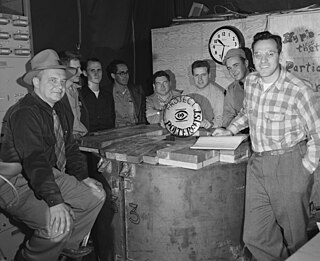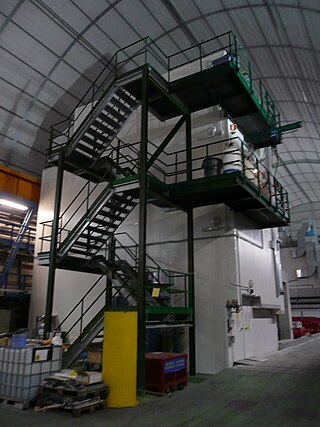Related Research Articles

A neutrino is an elementary particle that interacts via the weak interaction and gravity. The neutrino is so named because it is electrically neutral and because its rest mass is so small (-ino) that it was long thought to be zero. The rest mass of the neutrino is much smaller than that of the other known elementary particles. The weak force has a very short range, the gravitational interaction is extremely weak due to the very small mass of the neutrino, and neutrinos do not participate in the electromagnetic interaction or the strong interaction. Thus, neutrinos typically pass through normal matter unimpeded and undetected.
Weakly interacting massive particles (WIMPs) are hypothetical particles that are one of the proposed candidates for dark matter.

A scintillator is a material that exhibits scintillation, the property of luminescence, when excited by ionizing radiation. Luminescent materials, when struck by an incoming particle, absorb its energy and scintillate. Sometimes, the excited state is metastable, so the relaxation back down from the excited state to lower states is delayed. The process then corresponds to one of two phenomena: delayed fluorescence or phosphorescence. The correspondence depends on the type of transition and hence the wavelength of the emitted optical photon.
In experimental and applied particle physics, nuclear physics, and nuclear engineering, a particle detector, also known as a radiation detector, is a device used to detect, track, and/or identify ionizing particles, such as those produced by nuclear decay, cosmic radiation, or reactions in a particle accelerator. Detectors can measure the particle energy and other attributes such as momentum, spin, charge, particle type, in addition to merely registering the presence of the particle.

The Cowan–Reines neutrino experiment was conducted by physicists Clyde Cowan and Frederick Reines in 1956. The experiment confirmed the existence of neutrinos. Neutrinos, subatomic particles with no electric charge and very small mass, had been conjectured to be an essential particle in beta decay processes in the 1930s. With neither mass nor charge, such particles appeared to be impossible to detect. The experiment exploited a huge flux of electron antineutrinos emanating from a nearby nuclear reactor and a detector consisting of large tanks of water. Neutrino interactions with the protons of the water were observed, verifying the existence and basic properties of this particle for the first time.

Neutron detection is the effective detection of neutrons entering a well-positioned detector. There are two key aspects to effective neutron detection: hardware and software. Detection hardware refers to the kind of neutron detector used and to the electronics used in the detection setup. Further, the hardware setup also defines key experimental parameters, such as source-detector distance, solid angle and detector shielding. Detection software consists of analysis tools that perform tasks such as graphical analysis to measure the number and energies of neutrons striking the detector.

A neutrino detector is a physics apparatus which is designed to study neutrinos. Because neutrinos only weakly interact with other particles of matter, neutrino detectors must be very large to detect a significant number of neutrinos. Neutrino detectors are often built underground, to isolate the detector from cosmic rays and other background radiation. The field of neutrino astronomy is still very much in its infancy – the only confirmed extraterrestrial sources as of 2018 are the Sun and the supernova 1987A in the nearby Large Magellanic Cloud. Another likely source is the blazar TXS 0506+056 about 3.7 billion light years away. Neutrino observatories will "give astronomers fresh eyes with which to study the universe".
T2K is a particle physics experiment studying the oscillations of the accelerator neutrinos. The experiment is conducted in Japan by the international cooperation of about 500 physicists and engineers with over 60 research institutions from several countries from Europe, Asia and North America and it is a recognized CERN experiment (RE13). T2K collected data within its first phase of operation from 2010 till 2021. The second phase of data taking is expected to start in 2023 and last until commencement of the successor of T2K – the Hyper-Kamiokande experiment in 2027.
The Kamioka Observatory, Institute for Cosmic Ray Research, University of Tokyo is a neutrino and gravitational waves laboratory located underground in the Mozumi mine of the Kamioka Mining and Smelting Co. near the Kamioka section of the city of Hida in Gifu Prefecture, Japan. A set of groundbreaking neutrino experiments have taken place at the observatory over the past two decades. All of the experiments have been very large and have contributed substantially to the advancement of particle physics, in particular to the study of neutrino astronomy and neutrino oscillation.

SNOLAB is a Canadian underground science laboratory specializing in neutrino and dark matter physics. Located 2 km below the surface in Vale's Creighton nickel mine near Sudbury, Ontario, SNOLAB is an expansion of the existing facilities constructed for the original Sudbury Neutrino Observatory (SNO) solar neutrino experiment.
Astroparticle physics, also called particle astrophysics, is a branch of particle physics that studies elementary particles of astrophysical origin and their relation to astrophysics and cosmology. It is a relatively new field of research emerging at the intersection of particle physics, astronomy, astrophysics, detector physics, relativity, solid state physics, and cosmology. Partly motivated by the discovery of neutrino oscillation, the field has undergone rapid development, both theoretically and experimentally, since the early 2000s.

SNO+ is a physics experiment designed to search for neutrinoless double beta decay, with secondary measurements of proton–electron–proton (pep) solar neutrinos, geoneutrinos from radioactive decays in the Earth, and reactor neutrinos. It could also observe supernovae neutrinos if a supernova occurs in our galaxy. It is under construction using the underground equipment already installed for the former Sudbury Neutrino Observatory (SNO) experiment at SNOLAB.

DEAP is a direct dark matter search experiment which uses liquid argon as a target material. DEAP utilizes background discrimination based on the characteristic scintillation pulse-shape of argon. A first-generation detector (DEAP-1) with a 7 kg target mass was operated at Queen's University to test the performance of pulse-shape discrimination at low recoil energies in liquid argon. DEAP-1 was then moved to SNOLAB, 2 km below Earth's surface, in October 2007 and collected data into 2011.

The Cryogenic Rare Event Search with Superconducting Thermometers (CRESST) is a collaboration of European experimental particle physics groups involved in the construction of cryogenic detectors for direct dark matter searches. The participating institutes are the Max Planck Institute for Physics (Munich), Technical University of Munich, University of Tübingen (Germany), University of Oxford, the Comenius University Bratislava (Slovakia) and the Istituto Nazionale di Fisica Nucleare.

Borexino is a deep underground particle physics experiment to study low energy (sub-MeV) solar neutrinos. The detector is the world's most radio-pure liquid scintillator calorimeter and is protected by 3,800 meters of water-equivalent depth. The scintillator is pseudocumene and PPO which is held in place by a thin nylon sphere. It is placed within a stainless steel sphere which holds the photomultiplier tubes (PMTs) used as signal detectors and is shielded by a water tank to protect it against external radiation. Outward pointing PMT's look for any outward facing light flashes to tag incoming cosmic muons that manage to penetrate the overburden of the mountain above. Neutrino energy can be determined through the number of photoelectrons measured in the PMT's. While the position can be determined by extrapolating the difference in arrival times of photons at PMT's throughout the chamber.

The European Underground Rare Event Calorimeter Array (EURECA) is a planned dark matter search experiment using cryogenic detectors and an absorber mass of up to 1 tonne. The project will be built in the Modane Underground Laboratory and will bring together researchers working on the CRESST and EDELWEISS experiments.
Large Apparatus studying Grand Unification and Neutrino Astrophysics or LAGUNA was a European project aimed to develop the next-generation, very large volume underground neutrino observatory. The detector was to be much bigger and more sensitive than any previous detector, and make new discoveries in the field of particle and astroparticle physics. The project involved 21 European institutions in 10 European countries, and brought together over 100 scientists.

The Cryogenic Underground Observatory for Rare Events (CUORE) – also cuore (Italian for 'heart'; ) – is a particle physics facility located underground at the Laboratori Nazionali del Gran Sasso in Assergi, Italy. CUORE was designed primarily as a search for neutrinoless double beta decay in 130Te, a process that has never been observed. It uses tellurium dioxide (TeO2) crystals as both the source of the decay and as bolometers to detect the resulting electrons. CUORE searches for the characteristic signal of neutrinoless double beta decay, a small peak in the observed energy spectrum around the known decay energy; for 130Te, this is Q = 2527.518 ± 0.013 keV. CUORE can also search for signals from dark matter candidates, such as axions and WIMPs.
Daniel Nicholas McKinsey is an American experimental physicist. McKinsey is a leader in the field of direct searches for dark matter interactions, and serves as Co-Spokesperson of the Large Underground Xenon experiment. and is an executive committee member of the LUX-ZEPLIN experiment. He serves as Director and Principal Investigator of the TESSERACT Project, and is also The Georgia Lee Distinguished Professor of Physics at the University of California, Berkeley.
Direct detection of dark matter is the science of attempting to directly measure dark matter collisions in Earth-based experiments. Modern astrophysical measurements, such as from the Cosmic Microwave Background, strongly indicate that 85% of the matter content of the universe is unaccounted for. Although the existence of dark matter is widely believed, what form it takes or its precise properties has never been determined. There are three main avenues of research to detect dark matter: attempts to make dark matter in accelerators, indirect detection of dark matter annihilation, and direct detection of dark matter in terrestrial labs. The founding principle of direct dark matter detection is that since dark matter is known to exist in the local universe, as the Earth, Solar System, and the Milky Way Galaxy carve out a path through the universe they must intercept dark matter, regardless of what form it takes.
References
- ↑ http://ccdb5fs.kek.jp/cgi-bin/img/allpdf?198809032 [ dead link ]
- ↑ L. Gonzalez-Mestres; D. Perret-Gallix (October 1988). "Cryogenic detectors: status and prospects" (PDF). Archived from the original (PDF) on 2016-03-04.